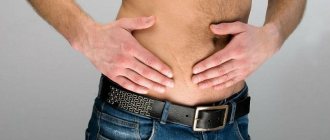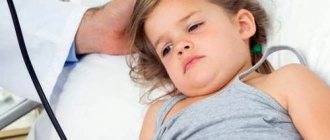Both men and women experience abdominal pain. Many of the causes are the same, but there are conditions that are more common in the stronger sex and those that occur only in men.
Pain in the lower abdomen occurs at or below the level of the navel.
“The reasons are varied and can come from different organs and systems,” says urologist -andrologist Rodion Vasilevsky. – For example, urological – prostatitis, overactive bladder, end-stage bladder and prostate cancer, lower ureter stones. Or neurological - diseases of the lumbosacral spine, chronic pelvic pain syndrome. Or proctological and general surgical – diseases of the large intestine, hernias and others.
Therefore, it can be difficult to pinpoint what is causing pain in the lower abdomen.
Causes of lower abdominal pain in men
Prostate diseases
Prostate damage is the most common cause of lower abdominal pain in men. Depending on the type of pathology and the duration of the process, the pain can be dull and aching, cutting, stabbing. Painful sensations radiate to the scrotum, groin, and hip joint area. They are combined with urination disorders and sexual dysfunction. Diseases that most often manifest as pain in the lower abdomen include:
- Acute prostatitis.
At the initial stages of the inflammatory process, pain of moderate intensity occurs, intensifying at night and during urination. The advanced process is characterized by sharp throbbing pain in the lower abdomen, in the perineum, which radiates to the rectum. To relieve symptoms, the patient lies with his legs drawn up to his body. - Chronic prostatitis.
Men are bothered by a constant dull pain in the pubic area, which becomes more intense at the beginning and at the end of urination. With prolonged abstinence from intimacy, the pain syndrome intensifies, but in some patients the opposite relationship occurs - severe discomfort in the lower abdomen is felt at the moment of ejaculation. - Prostate abscess.
With a large purulent process, very severe pain in the lower abdomen is noted, which is pulsating in nature. They often have unilateral localization, which corresponds to the affected lobe of the prostate gland. There is irradiation of painful sensations into the perineum and rectal area. - BPH.
The development of pain syndrome is characteristic of the subcompensated and decompensated stages, which is associated with urinary retention. Men experience dull, arching pain above the pubis; when palpating this area, the symptoms intensify. After urination the condition becomes easier. - Prostate cancer.
With a malignant tumor, unlike prostate adenoma, pain appears much earlier. They are constant, dull or aching, intensifying with ejaculation and urination. In the later stages, men develop extremely intense pain that is not relieved by standard analgesics.
Cystitis
In acute cystitis, patients experience pain and a feeling of heaviness above the pubic joint. There is a painful imperative urge to urinate, and at the end of urination, intense pain in the lower abdomen occurs. Patients notice that the urine becomes cloudy and acquires a strong, unpleasant odor. In the chronic form of cystitis, the pain is not intense; it usually occurs in men only before urinating.
Sexually transmitted infections
STIs include chlamydia, gonorrhea, ureaplasmosis, mycoplasmosis. Such infections in men are acute, accompanied by severe pain in the lower abdomen, radiating to the groin and penis. In addition to pain, patients complain of burning and itching in the urethra. Gradually the symptoms subside, aching pain in the suprapubic area bothers the man only in the morning. Another specific symptom of STIs is excessive purulent or mucous urethral discharge.
Urolithiasis disease
Severe pain in the lower abdomen with irradiation to the groin area occurs when stones are localized in the ureter. At the same time, patients behave restlessly, trying to find a position in which the painful sensations will not be so intense. The symptom is combined with nausea and vomiting, reflex retention of defecation and urination, which further aggravates the pain syndrome in men.
Pain in the lower abdomen in men
Tumors of the genitourinary system
The appearance of pain in the lower abdomen is typical for cancer of the bladder, urethra, germ cell and non-germ testicular tumors. Malignant neoplasms cause a pain syndrome that worries men constantly and does not change during urination and sexual intercourse. At the initial stage of the tumor process, the sensations are aching and not intense. The growth of neoplasia leads to increased pain that becomes unbearable.
Irritable bowel syndrome
IBS manifests itself as pain in the lower abdomen, varying in nature and intensity, in combination with flatulence. Unpleasant symptoms are most pronounced in the morning after waking up. Men complain of cramping pain, usually localized on the left. Against the background of pain, a painful urge to defecate occurs; after bowel movement, the state of health improves.
Inflammatory bowel diseases
Pain in the lower abdomen on the left is characteristic of ulcerative colitis, and on the right - for Crohn's disease. The intensity of the pain syndrome depends on the stage of the process: during exacerbation, men are bothered by severe dull or paroxysmal painful sensations. During the period of remission, there is slight discomfort in the abdomen. Symptoms are accompanied by increased frequency of bowel movements, the appearance of mucus and blood in the stool.
Appendicitis
In classic cases of inflammation of the appendix, intense pain is localized in men in the lower abdomen on the right. The pain intensifies when pressure is applied to the indicated area and the hand is suddenly released. With an atypical location of the appendicular process, pain is felt in the suprapubic zone. Pain in the rectal area and dysuric disorders are sometimes possible. A change in the nature of pain and its spread throughout the abdomen is a prognostically unfavorable sign.
Inguinal hernia
First, periodic dull pain in the lower abdomen is observed, accompanied by the appearance of a tumor-like protrusion in the groin. The pain is localized on the affected side. Often there is irradiation of pain in the lumbosacral region, perineum, and its intensification with straining and physical activity. As the hernia grows, the pain becomes constant. Acute cramping pain indicates the formation of a strangulated inguinal hernia.
Intestinal infections
With dysentery, escherichiosis, campylobacteriosis and some protozoal infections (amoebiasis, balantidiasis), patients feel severe spasms and pain in the lower abdomen, more on the left side. Along with the pain syndrome, men experience a painful urge to defecate, which can be false. Diarrhea develops up to 10-15 times a day with the release of a small amount of feces with mucus and streaks of blood. After defecation, the intensity of pain decreases.
Rare causes
- Inflammation of the genitourinary organs
: paracystitis, vesiculitis. - Blunt abdominal trauma.
- Vascular pathologies
: varicose veins of the small pelvis, Leriche syndrome. - Rare types of hernias
: perineal, Spigelian line, postoperative. - Chronic pelvic pain syndrome.
Symptoms caused by trigger points located in the abdominal muscles
Difficult-to-explain abdominal pain can often cause diagnostic confusion.
Referred pain caused by myofascial trigger points located in the abdominal muscles and somatovisceral effects can mimic diseases of the internal organs and systems.
In another case, on the contrary, with diseases of internal organs and systems, there is a profound impact on the sensitive somatic system of reflex activity. At the same time, active myofascial trigger points are aggravated, which causes the persistence of pain and other symptoms for a long time, even after the patient has recovered from the initial disease.
Active myofascial trigger points, localized in the abdominal muscles, for example, in the rectus muscle, can cause conditions such as: difficult muscle contraction, with the inability to “pull in” the stomach, relaxation, bloating. It is important to differentiate this condition from ascites.
Referred pain in the right upper quadrant can be caused by trigger points located along the outer edge of the rectus abdominis muscle. They can mimic the pain that accompanies gallbladder disease.
Referred pain simulating appendicitis may be projected from trigger points located in the lateral border of the rectus abdominis muscle and in the right lower quadrant.
Diagnostics
A urologist or gastroenterologist examines men with complaints of pain in the lower abdomen. The examination begins with superficial and deep palpation of the abdomen to identify local soreness and muscle tension. Then a digital examination of the prostate is performed through the rectum - the size and consistency of the gland are determined, and a pain reaction is detected. To find out the cause of the pain syndrome, a full range of diagnostic methods is selected, which includes:
- Ultrasonography
. During an ultrasound of the prostate gland, its shape and size are assessed, local or diffuse changes in the structure are determined. Using Doppler ultrasound, blood flow in the prostate is visualized. An ultrasound of the abdominal cavity is required to exclude inflammatory or tumor processes in the gastrointestinal tract. - Endoscopy
. For chronic pathologies of the urinary tract, the results of urethroscopy and cystoscopy are indicative. For detailed visualization of the condition of the large intestine, sigmoidoscopy and colonoscopy are performed. During endoscopic examination, it is possible to take a biopsy from suspicious areas of the mucosa. - X-ray studies
. If there is a suspicion of urological diseases in men, urethrography and cystography are recommended. If there are symptoms of intestinal damage, irrigography is prescribed. For the diagnosis of large tumors and chronic inflammatory processes, CT of the pelvic organs is informative. - Histological examination
. To verify prostate cancer, a transrectal targeted biopsy is indicated, the material of which is studied under a microscope. Analysis of the microstructure of the intestinal wall is important for the differential diagnosis of UC and Crohn's disease, and the identification of intestinal tumors in men. - Laboratory methods
. Culture of a urethral smear is required to confirm the diagnosis of an STI. Clinical and bacteriological examination of urine helps to establish cystitis and urethritis. In case of dyspeptic disorder, a coprogram is required. If prostate cancer is suspected, a PSA blood test is performed.
Consultation with a urologist
Etiology
A precise explanation of the trigger point phenomenon has not yet been obtained. There are certain results of electromyography of trigger points that revealed low-voltage activity of these points, reminiscent of action potentials. It is hypothesized that a myofascial trigger point is a cluster of numerous microscopic lesions with intense activity throughout the nodule. These lesions are thought to arise from a focal metabolic disorder due to trauma or frequent exposure. Factors commonly considered to predispose to the formation of a trigger point include deterioration of the general condition of the body, poor posture, repetitive mechanical stress, sleep disturbance, vitamin deficiency.
Treatment
Help before diagnosis
Considering that pain in the lower abdomen in men can have different origins, self-medication and independent use of painkillers are not recommended. To relieve symptoms, you should regularly empty your bladder and bowels and avoid prolonged sexual abstinence. Severe pain, combined with deterioration in well-being, is an indication for seeking emergency medical help.
Conservative therapy
In order to prevent polypharmacy, treatment of men with lower abdominal pain begins only after verification of the diagnosis. Treatment of most mild and moderate forms of diseases is carried out on an outpatient basis, and for severe and complicated diseases, hospitalization is necessary. The treatment regimen includes several groups of drugs, the main of which are:
- Antibiotics
. Medicines are prescribed for the treatment of acute and chronic prostatitis, STIs, and intestinal infections. The selection of the drug is carried out empirically, the drug regimen is adjusted after receiving the results of the antibiogram. - Alpha blockers
. Medicines relieve spasm of smooth muscles in men, facilitate the passage of urine, and therefore the pain syndrome decreases. For prostate adenoma, therapy is supplemented with 5-alpha reductase inhibitors. - Nonsteroidal anti-inflammatory drugs
. NSAIDs have a powerful analgesic effect, therefore they are used in both pathogenetic and symptomatic treatment of lower abdominal pain in men. - Immunomodulators
. Medicines that stimulate the immune system are necessary for chronic inflammatory and infectious processes. They prevent exacerbations and speed up the treatment process for men. - Cytostatics
. The drugs are effective in inflammatory bowel diseases to control symptoms and reduce the frequency of exacerbations. Cytostatics are included in the chemotherapy of genitourinary cancer in men.
For chronic prostatitis, prostate massage is widely used, which is necessary to eliminate congestion in the organ. For urological pain, physiotherapy methods are used: laser exposure, ultrasound and electromagnetic therapy, therapeutic microenemas. For IBS associated with psychoemotional disorders, psychotherapy techniques have a good effect.
Surgery
In the presence of prostate adenoma, several surgical options are used: transurethral resection, adenomectomy, laser vaporization of the prostate. In complicated forms of prostatitis, a puncture is performed with drainage of cysts and abscesses. Men with prostate cancer require radical surgery, which includes prostatectomy and lymph node dissection.
To treat urolithiasis, endoscopic operations (contact cystolithotripsy and ureterolithotripsy) and laparoscopic methods (nephrolithotomy, ureterolithotomy) are used. For inguinal hernias, hernioplasty is performed with the installation of mesh allografts. For appendicitis, gentle laparoscopic or classic laparotomic appendectomy is indicated.
Activation and long-term existence of myofascial trigger points
The reason for the long-term existence of myofascial trigger points can be structural and systemic factors, as well as posture and physical activity that are not corrected in a timely manner.
Muscles that are acutely or chronically overused can cause trigger points. Severe injuries, diseases of internal organs, emotional stress, as well as mechanical and toxic stress can cause the development of myofascial trigger points.
The location of active myofascial trigger points of the rectus abdominis muscle is usually the angle between the xiphoid process and the costal arch or between the umbilicus and the xiphoid process. In addition, trigger points can be located in the middle or lower part of the rectus abdominis muscle, along its lateral edge and in the area where the muscle attaches to the pubic bone.
Releasing Myafascial Trigger Points
Release from myafascial trigger points is facilitated by post-isometric relaxation, methods of contraction and relaxation, methods of cooling and stretching the abdominal muscles. The release method using fingertip pressure on a painful trigger point is only applicable to the superficial external rectus abdominis muscle. To treat myofascial trigger points at the insertions of the abdominal muscles, it becomes necessary to inactivate the central trigger point that causes them.
Corrective Actions
The persistence of the activity of the myofascial trigger point for a long time after the onset of an acute disease of the internal organ is facilitated by the fact that the initial cause, that is, the underlying disease - a tumor, stomach ulcer, intestinal paresis - has not been eliminated. Therefore, treatment aimed at getting rid of myofascial trigger points will give a temporary, partial effect. For a complete cure, it is necessary to eliminate the causative factor - a disease of the internal organ.
When a muscle remains in a stressful state for a long time, such as: emotional stress, viral disease, mechanical distortion, poor posture, stoop, it is also important to eliminate the cause that does not contribute to healing.
The patient should place a small pillow on the chair to support the lower back and sit leaning back in the chair. In this position, the lumbar lordosis increases, the chest rises slightly, and the longitudinal muscle fibers of the abdominal wall stretch.
It is necessary to avoid wearing a tight belt in order to improve blood circulation in the muscles.
Physical exercise
It is important to regularly perform special exercises for a long time to maintain normal muscle tone and form the correct pattern of movements.
The patient needs to perform therapeutic exercises, consisting of exercises to strengthen the abdominal muscles, aimed at developing diaphragmatic breathing and eliminating pelvic distortion.
All rights reserved by copyright law. No part of the contents of the site may be used, reproduced, transmitted by any electronic, copying or other means without the prior written permission of the copyright owner.
Why is it so important to see a doctor promptly?
Painful symptoms in the pelvic area can signal a number of diseases of the genitourinary and musculoskeletal systems, as well as the gastrointestinal tract. Taking painkillers will only temporarily eliminate the symptom, but the cause that caused it will not be eliminated - and the disease will continue to develop, which is dangerous for health and life. By consulting a doctor in a timely manner and undergoing a diagnostic test, the patient will find out the cause of the pain and, together with the doctor, will be able to direct efforts to eliminate it, avoiding much more serious consequences, irreversible processes, and sometimes even surgical intervention. Do not delay your visit to the doctor under any circumstances if:
- pain symptoms have an intense paroxysmal nature;
- an admixture of blood is found in the urine or stool;
- internal organs hurt;
- there is headache, nausea, high body temperature;
- Women experience uterine bleeding.
Pathologies of the musculoskeletal system
One of the clinical manifestations of diseases of the musculoskeletal system is pain in the pelvic area.
.
| Disease | Clinical manifestations | Diagnostics | Treatment |
| Osteochondrosis of the sacrolumbar region |
|
|
|
| Herniated discs |
|
|
|
| Neoplasms of the pelvic bones, metastases to the spinal column |
|
|
|
| Arthrosis of the sacroiliac joint |
|
|
|
| Tuberculosis ODA |
|
|
|
Gastrointestinal pathologies
There are many diseases of the gastrointestinal tract that require treatment for pelvic pain
, along with eliminating the root cause that caused them.
| Disease | Clinical manifestations | Diagnostics | Treatment |
| Adhesions due to surgery, inflammatory processes, injuries | Painful pulling sensations in the abdomen, radiating to the pelvis and lower back. |
|
|
| Irritable bowel syndrome |
|
|
|
| Chronic colitis |
|
|
|
Which doctor should I contact?
A visit to the doctor is simply necessary if the pain does not stop for a long time and is accompanied by fever, numbness of the lower extremities, nausea, or if it occurs as a result of injury. If you want to be sure that you will be correctly diagnosed and treated at a high quality level, contact the CELT clinic. In order to become our patient and get rid of pain, it is not necessary to have a Moscow residence permit. Contact your doctor, and depending on the nature of the pain, the cause of its occurrence and accompanying symptoms, you will be referred to one of our specialists:
- pain management specialist;
- traumatologist-orthopedist;
- rheumatologist;
- neurologist;
- oncologist;
- physiotherapist;
- gynecologist;
- to a urologist.








